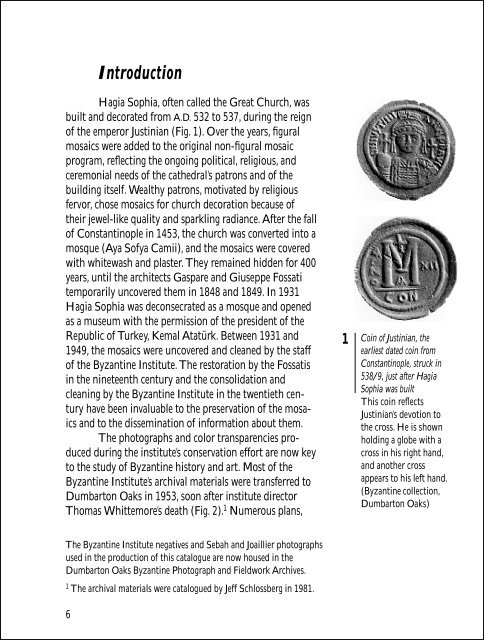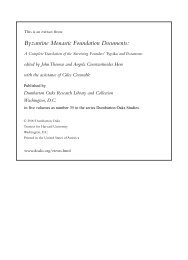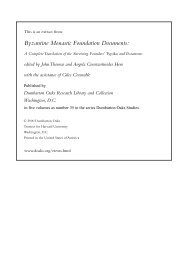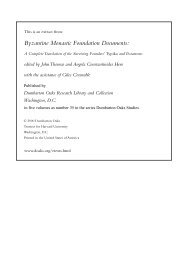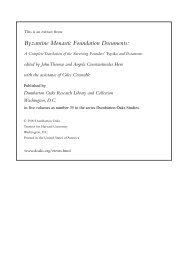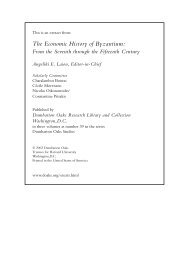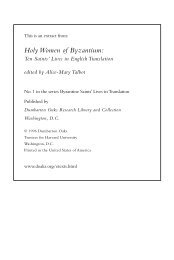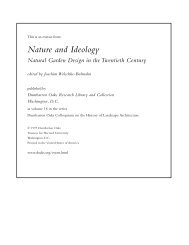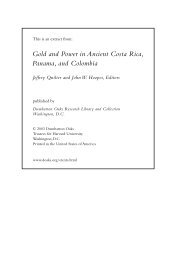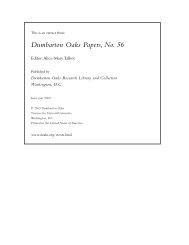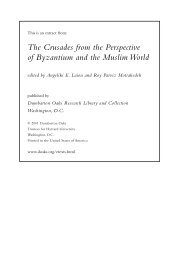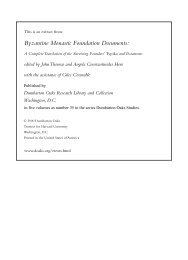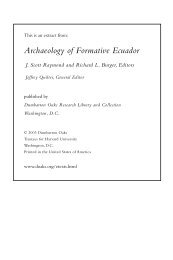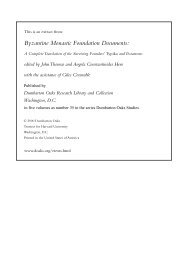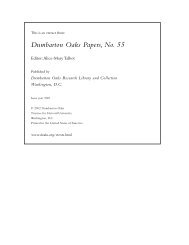Download: Mosaics of Hagia Sophia, Istanbul - Dumbarton Oaks
Download: Mosaics of Hagia Sophia, Istanbul - Dumbarton Oaks
Download: Mosaics of Hagia Sophia, Istanbul - Dumbarton Oaks
Create successful ePaper yourself
Turn your PDF publications into a flip-book with our unique Google optimized e-Paper software.
6<br />
Introduction<br />
<strong>Hagia</strong> <strong>Sophia</strong>, <strong>of</strong>ten called the Great Church, was<br />
built and decorated from A.D. 532 to 537, during the reign<br />
<strong>of</strong> the emperor Justinian (Fig. 1). Over the years, figural<br />
mosaics were added to the original non-figural mosaic<br />
program, reflecting the ongoing political, religious, and<br />
ceremonial needs <strong>of</strong> the cathedral’s patrons and <strong>of</strong> the<br />
building itself. Wealthy patrons, motivated by religious<br />
fervor, chose mosaics for church decoration because <strong>of</strong><br />
their jewel-like quality and sparkling radiance. After the fall<br />
<strong>of</strong> Constantinople in 1453, the church was converted into a<br />
mosque (Aya S<strong>of</strong>ya Camii), and the mosaics were covered<br />
with whitewash and plaster. They remained hidden for 400<br />
years, until the architects Gaspare and Giuseppe Fossati<br />
temporarily uncovered them in 1848 and 1849. In 1931<br />
<strong>Hagia</strong> <strong>Sophia</strong> was deconsecrated as a mosque and opened<br />
as a museum with the permission <strong>of</strong> the president <strong>of</strong> the<br />
Republic <strong>of</strong> Turkey, Kemal Atatürk. Between 1931 and<br />
1949, the mosaics were uncovered and cleaned by the staff<br />
<strong>of</strong> the Byzantine Institute. The restoration by the Fossatis<br />
in the nineteenth century and the consolidation and<br />
cleaning by the Byzantine Institute in the twentieth century<br />
have been invaluable to the preservation <strong>of</strong> the mosaics<br />
and to the dissemination <strong>of</strong> information about them.<br />
The photographs and color transparencies produced<br />
during the institute’s conservation effort are now key<br />
to the study <strong>of</strong> Byzantine history and art. Most <strong>of</strong> the<br />
Byzantine Institute’s archival materials were transferred to<br />
<strong>Dumbarton</strong> <strong>Oaks</strong> in 1953, soon after institute director<br />
Thomas Whittemore’s death (Fig. 2). 1 Numerous plans,<br />
The Byzantine Institute negatives and Sebah and Joaillier photographs<br />
used in the production <strong>of</strong> this catalogue are now housed in the<br />
<strong>Dumbarton</strong> <strong>Oaks</strong> Byzantine Photograph and Fieldwork Archives.<br />
1 The archival materials were catalogued by Jeff Schlossberg in 1981.<br />
1<br />
Coin <strong>of</strong> Justinian, the<br />
earliest dated coin from<br />
Constantinople, struck in<br />
538/9, just after <strong>Hagia</strong><br />
<strong>Sophia</strong> was built<br />
This coin reflects<br />
Justinian’s devotion to<br />
the cross. He is shown<br />
holding a globe with a<br />
cross in his right hand,<br />
and another cross<br />
appears to his left hand.<br />
(Byzantine collection,<br />
<strong>Dumbarton</strong> <strong>Oaks</strong>)


